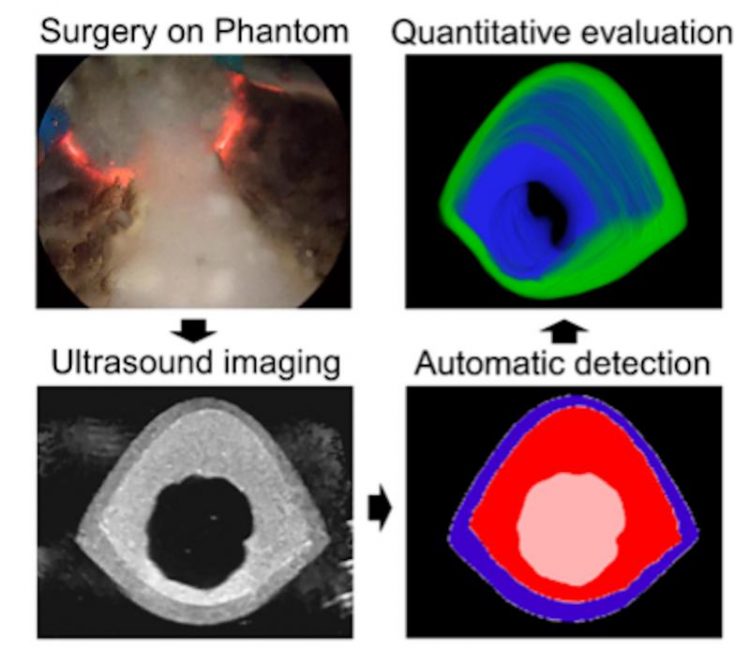Endoscopic prostate surgery performed on a first human-like phantom

Endoscopic surgery on the human-like phantom of the prostate. For the first time, the intelligent surgical simulator makes it possible to quantitatively evaluate the surgery’s outcome. Bildnachweis: E. Choi/MPI-IS
Airline pilots train many hundreds of hours in a flight simulator before they take to the skies. In contrast, surgeons have very limited access to simulators, and the simulators that are available do not offer sufficiently realistic conditions.
To improve the situation and allow for surgical procedures to be optimized and quantitatively evaluated, scientists from the Max Planck Institute for Intelligent Systems in Stuttgart and the University of Stuttgart have developed the first organ model that can be used for a realistic transurethral resection of the prostate.
In collaboration with the Division of Urotechnology at the Medical Center – University of Freiburg, a team of doctors used the same surgical set-up and equipment routinely used on patients to perform surgery on the organ phantom, which is made of materials that behave like real tissue.
With the phantom, the surgery’s outcome can be clearly visualized, which is impossible on real patients. The team has developed an automatic system to evaluate surgical performance and provide feedback to the trainee surgeon immediately after the training session.
At some point in their lives, 80% of men suffer from the enlargement of the prostate, which is known as benign prostate hyperplasia (BPH). BPH can be treated surgically, most commonly in a minimally invasive procedure called transurethral resection of the prostate (TURP).
During the surgery, a rigid endoscope is inserted through the patient’s urethra and prostate tissue is cut out from the inside with a wire loop that is heated with an electrical current. While the prostate’s central zone should be removed, the peripheral zone must be preserved.
An experienced surgeon is capable of distinguishing the inner and outer zones based on the tactile feedback from the endoscope and appearance of the tissue. Developing this ability requires a great deal of practice.
The new prostate phantom can help in this regard. It provides a unique opportunity for surgical training without the risk of patients being harmed.
The realistic phantom was fabricated by 3D printing and molding, and the researchers used special biomimetic materials to provide the correct level of softness, the right appearance, and the appropriate response to the surgical resection instrument.
In addition, imaging contrast agents were added that became visible only after the surgery and made the two different zones clearly visible. As a result, the surgeon can obtain feedback on the accuracy of the resection for the first time.
“The organ phantom feels very realistic and the surgery feels like operating on a real patient”, says Professor Arkadiusz Miernik, a senior urology consultant and the head of the Division of Urotechnology at the Medical Center – University of Freiburg.
“The phantom will transform surgical training. Compared with cadaver or animal models, it is much more pleasant to use, saves time and money, and can be designed for special procedures. The phantom also provides valuable feedback on how to improve one’s surgical skills.”
The research team headed by Tian Qiu, leader of the Cyber Valley Biomedical Microsystems research group at the University of Stuttgart, and Peer Fischer, Professor of Physical Chemistry at the University of Stuttgart and leader of the Micro, Nano and Molecular Systems Lab at the Max Planck Institute for Intelligent Systems in Stuttgart, is also developing other organ phantoms. In so doing, the researchers aim to make it possible to teach, optimize, and systemically validate more surgical procedures, including new robotic surgeries. Their ultimate goal is to develop a comprehensive and realistic surgical simulator.
Reference
Eunjin Choi, Fabian Adams, Stefano Palagi, Anina Gengenbacher, Daniel Schlager, Philippe-Fabian Müller, Christian Gratzke, Arkadiusz Miernik, Peer Fischer, Tian Qiu. A High-Fidelity Phantom for the Simulation and Quantitative Evaluation of Transurethral Resection of the Prostate. Annals Biomedical Engineering (2019). https://doi.org/10.1007/s10439-019-02361-7
Dr. Tian Qiu
Cyber Valley Group Leader
University of Stuttgart
Pfaffenwaldring 55, 70569 Stuttgart, Germany
Tel: +49 (0) 711 685 64482
Email: tian.qiu@ipc.uni-stuttgart.de
Media Contact
All latest news from the category: Medical Engineering
The development of medical equipment, products and technical procedures is characterized by high research and development costs in a variety of fields related to the study of human medicine.
innovations-report provides informative and stimulating reports and articles on topics ranging from imaging processes, cell and tissue techniques, optical techniques, implants, orthopedic aids, clinical and medical office equipment, dialysis systems and x-ray/radiation monitoring devices to endoscopy, ultrasound, surgical techniques, and dental materials.
Newest articles

High-energy-density aqueous battery based on halogen multi-electron transfer
Traditional non-aqueous lithium-ion batteries have a high energy density, but their safety is compromised due to the flammable organic electrolytes they utilize. Aqueous batteries use water as the solvent for…

First-ever combined heart pump and pig kidney transplant
…gives new hope to patient with terminal illness. Surgeons at NYU Langone Health performed the first-ever combined mechanical heart pump and gene-edited pig kidney transplant surgery in a 54-year-old woman…

Biophysics: Testing how well biomarkers work
LMU researchers have developed a method to determine how reliably target proteins can be labeled using super-resolution fluorescence microscopy. Modern microscopy techniques make it possible to examine the inner workings…





















